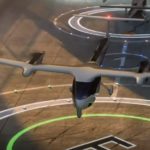The brightest brands and brains are investing in the dream of a supersonic and hypersonic future. FINN editor-in-chief Alan Peaford reports on a vision which is fast becoming reality
Talking to Blake Scholl, the founder, CEO and the man with the vision behind the Boom supersonic aircraft on the eve of the October roll-out of his XB-1 demonstrator, it was impossible not to be swept along on the tsunami of enthusiasm, positivity and belief.
Around the whole aerospace industry there has been muttered cynicism about plans for “supersonic revival” and more recently “hypersonic travel”.
I guess it’s a bit like the chaps in the late 1890s popping into the Wright Brothers Ohio bicycle shop for a new penny farthing and seeing them messing around with kites and talking with a wild gleam in their eyes about man taking to the skies in a heavier-than-air vehicle. But right now, the naysayers are fidgeting in their seats. Conservative global players are taking an interest. Blue chip firms like GE, Rolls-Royce, Honeywell, Boeing, Safran are putting their hands in their pockets to find cash and put their own brightest brains onto developing products that could – sorry Blake – WILL see us making this new leap in time travel within the next decade.
No longer “the impossible dream”
Attitudes are changing. It is no longer “an impossible dream,” it is now a maybe. We look back on Concorde with a certain amount of awe and fascination. A bit like we do with the Moon landings. A point that is not lost on Scholl. “Concorde’s first flight and the first moon landing happened in 1969, fifty years ago last year. But half a century later, if you want a supersonic airliner or lunar lander, you go to a museum rather than the airports or the skies,” he says.
And he has a point. Scholl will explain that those flagship moments of the 20th century were born out of political or nationalistic ambitions. The Americans needed to get to the Moon to show they had better technology and capabilities than the Soviets; The Anglo-French partnership that created Concorde was at the heart of cold war era and again had to demonstrate superiority for national pride.
Value comes through selling time
With the US Congress having abandoned support for an American supersonic aircraft, it was only natural to hinder the progress of others by restricting transit. But neither of these projects had any true commercial value – and that is what differs now.
There is value in selling time – and according to Scholl it is will be in demand.
“This is about making your world bigger. When flights are shorter, where can you vacation? Where can you do business? Who can you fall in love with? It’s about how a donor heart that goes twice as fast can go twice as far to save someone’s life,” he says.
Aerion could be airborne by 2027
While Boom is focused on delivering its Overture passenger jet, another US supersonic project is quietly heading towards reality. Aerion has been touting its the supersonic business jet since 2002. Founded by Texas billionaire Robert Bass, its first AS2 business jet that will travel at roughly double that of traditional commercial aircraft, could be flying as early as 2027.
It has been a long and rocky road but Bass’ team of industry veterans have been resolute in their belief over the years. And former cynics are now partners.
The partnership with GE will deliver the first commercial supersonic power plant to be designed in more than five decades. The Affinity engine will also be the first designed to run on traditional kerosene and synthetic fuel made in part by capturing carbon dioxide from the air.
Flight control systems are coming from BAE Systems – an original partner on Concorde. Landing gear, Nacelles and braking systems from Safran; Spirit Aerosystems will manufacturer forward fuselage structure; PPG will provide the flight deck windshields and cabin window transparencies. All are backing the reality of the programme.
Other players are joining race for supersonic air travel
The US government is looking at Boom as well as Exosonic and Hermeus for a Presidential supersonic or even hypersonic aircraft.
There are others in the race too. Spike has plans for an 18-passenger, Mach 1.6, S-512 business jet with a potential stretch for a commercial passenger jet. Now, with a group of industry veterans including former Gulfstream and Virgin C-suite managers its plans for a low sonic boom over land model, could accelerate. Russian manufacturers have also revealed plans for a clean-sheet aircraft rather than initial plans for a military aircraft conversion.
Virgin Galactic closes in on hypersonic travel
But even before we have gone supersonic, attention is heading way ahead with hypersonic.
In an interview with Bloomberg News earlier this month, Aerion’s CEO, Tom Vice, said: “Our long-term vision is to allow people to travel between any two points on the planet within three hours.”
Already close to those heights are on the cards with Virgin Galactic whose push for “space tourism” is edging closer.
The company announced in August that it has plans for 19-seat aircraft flying at three times the speed of sound, which it sees as an interim step on the way to hypersonic point-to-point travel. UK manufacturer Rolls-Royce – which is also working with Boom on supersonic engine technologies – will be the power behind the plan. Rolls-Royce is already in partnership with Reaction Engines, another UK firm also with a heritage from space. Reaction has developed a Synergetic Air Breathing Rocket Engine – SABRE – which contains pre-cooler technology able to deal with extreme temperatures found at incredibly high speeds.
Biggest challenges will be political
Of course, there are some that say it will not work and the powerplant will burn up after each flight. But perhaps the biggest challenge will be the political one. The visionaries ARE planning sustainable aircraft. They ARE reducing emissions and noise. But will the commercial support from the major companies, and the international collaboration make a difference?
Perhaps some plans will be hit by Covid-19 as we see Boeing (an investor in Aerion) pull out of its Boeing NeXt initiative while airlines are struggling to keep conventional airliners with the lack of demand the globe is experiencing.
According to Bloomburg, analysts share their doubts. “Supersonic business jets remain an intriguing idea. Supersonic airliners remain unlikely,” says Richard Aboulafia, from the Teal Group. “Hypersonic travel remains a very remote prospect. If anyone can build a hypersonic weapon that functions (other than a rocket), then a few decades later we might see this technology commercialised.”
But then again, maybe he hasn’t listened to Blake Scholl. It will all become clear.

